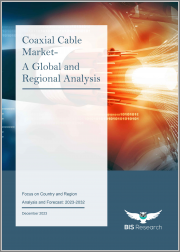
|
시장보고서
상품코드
1397513
세계의 동축 케이블 시장 : 국가 및 지역별 분석과 예측(2023-2032년)Coaxial Cable Market - A Global and Regional Analysis: Focus on Country and Region - Analysis and Forecast, 2023-2032 |
||||||
세계 동축 케이블 시장 규모는 2022년 176억 6,000만 달러에서 예측 기간 동안 7.63%의 CAGR을 기록하며 2032년에는 384억 4,000만 달러 규모로 성장할 것으로 예상됩니다.
동축 케이블 산업의 지속적인 성장을 촉진하는 주요 요인은 고화질(HD) 및 초고화질(UHD) 컨텐츠의 보급입니다. 더 나은 영상 및 음성 경험을 원하는 소비자가 증가함에 따라, 케이블 TV 제공업체와 방송사들은 이러한 고급 포맷을 지원하기 위해 인프라를 업그레이드하고 있습니다.
| 주요 시장 통계 | |
|---|---|
| 예측 기간 | 2023-2032년 |
| 2023년 평가 | 198억 3,000만 달러 |
| 2032년 예측 | 384억 4,000만 달러 |
| CAGR | 7.63% |
동축 케이블 시장은 통신 부문의 확장과 고속 인터넷 서비스에 대한 수요 증가로 인해 크게 성장하고 있습니다. 동축 케이블은 광대역 인터넷 연결에서 매우 중요한 역할을 하며, 신뢰할 수 있고 비용 효율적인 고속 데이터 전송 수단을 제공합니다. 스트리밍 서비스, 온라인 게임 등 데이터 사용량이 많은 애플리케이션의 보급이 증가함에 따라 강력한 통신 인프라의 필요성이 강조되면서 고급 동축 케이블에 대한 수요를 촉진하고 있습니다.
또한 5G 네트워크의 구축은 동축 케이블 제품의 수요에 큰 영향을 미치며, 5G의 백홀과 프론트홀 연결에는 광섬유가 선호되지만, 동축 케이블은 셀 타워와 기지국을 코어 네트워크에 연결하여 네트워크 분배에 중요한 역할을 합니다. 고주파 신호를 지원하는 동축 케이블의 능력은 5G 통신의 요구 사항과 일치하여 진화하는 무선 통신 상황에서 지속적인 타당성을 보장합니다. 통신 외에도 산업 부문은 특히 안정적인 신호 전송이 중요한 응용 분야에서 동축 케이블의 수요에 기여하고 있습니다. 제조, 에너지, 운송 등의 산업은 시설 내 통신, 모니터링 시스템, 제어 애플리케이션에 동축 케이블을 사용하며, 전자기 간섭과 신호 저하가 문제가 될 수 있는 열악한 산업 환경에서 동축 케이블의 내구성과 차폐 특성을 활용하고 있습니다.
동축 케이블 생태계의 진화는 케이블 성능 향상을 목표로 한 지속적인 기술 발전에 의해 추진되고 있습니다. 제조업체들은 대역폭을 늘리고, 신호 손실을 줄이고, 전반적인 효율을 향상시키기 위해 지속적으로 설계와 소재를 개선하고 있습니다. 혁신적인 기술에는 우수한 차폐 기술, 고급 유전체 재료, 신호 감쇠를 최소화하도록 설계된 커넥터 등이 포함됩니다. 동축 케이블은 광섬유와 같은 대체 기술과의 경쟁에도 불구하고 확고한 입지를 유지하고 있습니다. 광섬유는 장거리에서 높은 대역폭과 낮은 신호 손실이 필요한 애플리케이션에서 우수하지만, 동축 케이블은 특히 주택 및 중소기업의 라스트 마일 연결에서 비용 효율적이고 신뢰할 수 있는 솔루션을 제공하기 때문에 여전히 강세를 보이고 있습니다.
본 보고서는 세계 동축 케이블 시장을 조사했으며, 시장 배경과 개요, 시장 성장에 영향을 미치는 각종 요인 분석, 진행 중인 프로그램, 시장 규모 추이 및 예측, 지역별/주요 국가별 상세 분석, 주요 기업 분석 등의 정보를 정리하여 전해드립니다.
목차
주요 요약
조사 범위
제1장 시장
- 업계 전망
- 동향 : 현재와 미래
- 공급망 분석
- 생태계/진행중인 프로그램
- 규제기관
- 정부 프로그램
- 연구기관·대학에 의한 프로그램
- 주요 기업에 의한 지속가능한 대처
- 사업 역학
- 사업 촉진요인
- 사업상 과제
- 사업 기회
제2장 지역
- 북미
- 시장
- 북미 : 국가 레벨 분석
- 유럽
- 시장
- 유럽 : 국가 레벨 분석
- 아시아태평양과 일본
- 시장
- 아시아태평양과 일본 : 국가 레벨 분석
- 중동 및 아프리카
- 시장
- 중동 및 아프리카 : 국가 레벨 분석
- 기타 지역
- 시장
제3장 시장
- 기업 개요
- Belden Inc.
- Fujikura Ltd.
- Furukawa Electric Co., Ltd.
- LS Cable & System Ltd.
- Sumitomo Electric Industries, Ltd.
- RS Components Ltd
- Amphenol Corporation
- R R Kabel Ltd.
제4장 조사 방법
ksm 24.01.03“The Global Coaxial Cable Market Expected to Reach $38.44 Billion by 2032.”
Coaxial Cable Market Overview
The coaxial cable market was valued at $17.66 billion in 2022, and it is expected to grow at a CAGR of 7.63% and reach $38.44 billion by 2032. A key factor fueling the ongoing expansion of the coaxial cable industry is the widespread adoption of high-definition (HD) and ultra-high-definition (UHD) content. With consumers increasingly demanding superior video and audio experiences, cable television providers and broadcasters are upgrading their infrastructure to accommodate these advanced formats.
| KEY MARKET STATISTICS | |
|---|---|
| Forecast Period | 2023 - 2032 |
| 2023 Evaluation | $19.83 Billion |
| 2032 Forecast | $38.44 Billion |
| CAGR | 7.63% |
The coaxial cable market experiences significant growth driven by the expanding telecommunications sector and heightened demand for high-speed internet services. Coaxial cables play a pivotal role in broadband internet connections, offering a reliable and cost-effective means of transmitting data at high speeds. The increasing prevalence of data-intensive applications such as streaming services and online gaming emphasizes the necessity for robust communication infrastructure, fueling the demand for advanced coaxial cables.
Moreover, the deployment of 5G networks significantly influences the coaxial cable product demand. While fiber optics are favored for 5G backhaul and fronthaul connections, coaxial cables play a crucial role in distributing networks by connecting cell towers and base stations to the core network. Their capacity to support high-frequency signals aligns with the demands of 5G communication, ensuring their continued relevance in the evolving wireless communication landscape. Beyond telecommunications, the industrial sector contributes to coaxial cable demand, particularly in applications where reliable signal transmission is critical. Industries such as manufacturing, energy, and transportation rely on coaxial cables for communication within facilities, monitoring systems, and control applications, leveraging their durability and shielding properties in challenging industrial environments where electromagnetic interference and signal degradation may pose challenges.
The evolution of the coaxial cable ecosystem is driven by continuous technological advancements aimed at improving cable performance. Manufacturers are consistently refining designs and materials to enhance bandwidth, reduce signal loss, and improve overall efficiency. Innovations include superior shielding techniques, advanced dielectric materials, and connectors designed to minimize signal attenuation. Despite facing competition from alternative technologies such as fiber optics, coaxial cables maintain their robust presence. While fiber optics excel in applications requiring high bandwidth and low signal loss over extended distances, coaxial cables remain thriving, providing a cost-effective and reliable solution, especially in last-mile connectivity for residential and small business applications.
Impact:
The coaxial cables remains integral to the fabric of modern communication infrastructure. The demand for high-quality video content, the expansion of telecommunications networks, the advent of 5G technology, and the requirements of various industrial applications collectively propel the growth of this market. Technological advancements continue to enhance the capabilities of coaxial cables, ensuring their relevance in a rapidly evolving landscape where reliable and efficient signal transmission is of utmost importance.
Market Segmentation:
Segmentation 1: by Region
- North America
- Europe
- Asia-Pacific and Japan
- Middle East and Africa
- Rest-of-the-World
The coaxial cable market in the Asia-Pacific and Japan region is experiencing significant expansion, primarily propelled by increased investments in telecommunications infrastructure and a rising demand for high-speed internet services. The region's swift urbanization and the ongoing push for digitalization have intensified the requirement for dependable communication networks. Coaxial cables, known for their cost-effectiveness and efficient data transmission capabilities, play a pivotal role in fulfilling these needs. Furthermore, the robust industrial development and the continuous introduction of advanced broadcasting technologies in the region contribute to the growing adoption of coaxial cables. This expansion underscores the essential role these cables play in supporting diverse applications throughout the Asia-Pacific and Japan.
Recent Developments in the Coaxial Cable Market
- In February 2022, Comcast Cable revealed a collaboration with Echo Environmental Holdings, LLC, an Envela Corporation subsidiary, to implement an innovative recycling solution for its range of coaxial cable products.
- In October 2021, LS Cable & System Ltd. developed and launched its next-generation 23kV 3-phase coaxial superconducting cable that has almost no power loss during transmission and is capable of large-capacity transmission.
Demand - Drivers and Limitations
Following are the drivers for the coaxial cable market:
- Increase of Investments in the Telecommunication Industry
- Increase in Demand for Sustainable Wire and Cable Products
- Rise of Industrial Revolution 4.0
- Integration of Connectivity in the Automotive Sector and Increase in Sales of Electric Vehicles
Following are the limitations of the coaxial cable market:
- Fluctuations in Raw Material Prices
- Increase in Demand for Fiber Optic Cables
How can this report add value to an organization?
Product/Innovation Strategy: The product strategy helps the readers understand the different aftermarket solutions provided by the industry participants.
Growth/Marketing Strategy: The coaxial cable market is growing at a significant pace and holds enormous opportunities for market players. Some of the strategies covered in this segment are product launches, partnerships, collaborations, business expansions, and investments. The companies' preferred strategy has been product launches, partnerships, and collaborations to strengthen their positions in the global coaxial cable market.
Competitive Strategy: The key players in the coaxial cable market analyzed and profiled in the study include coaxial cable manufacturers, raw material suppliers, and wholesalers and distributors. Additionally, comprehensive competitive strategies such as partnerships, agreements, and collaborations will aid the reader in understanding the untapped revenue pockets in the market.
Key Market Players and Competition Synopsis
The companies that are profiled have been selected based on inputs gathered from primary experts and analyzing company coverage, product portfolio, and regional presence.
Some of the prominent names in this market are:
|
|
Other related companies in the fiber optic cable ecosystem are:
|
|
Companies that are not a part of the aforementioned pool have been well represented across different sections of the report (wherever applicable).
Table of Contents
Executive Summary
Scope of the Study
1. Markets
- 1.1. Industry Outlook
- 1.1.1. Trends: Current and Future
- 1.1.1.1. Increase in Use of Renewable Energy
- 1.1.1.2. Expansion of Smart Grid, Power Transmission, and Distribution Network
- 1.1.1.3. Growth in the Use of Automation and the Rise of Robotics
- 1.1.2. Supply Chain Analysis
- 1.1.2.1. Sourcing Raw Material
- 1.1.2.2. Production
- 1.1.2.3. Transportation
- 1.1.2.4. Product Customization
- 1.1.2.5. End User
- 1.1.1. Trends: Current and Future
- 1.2. Ecosystem/Ongoing Programs
- 1.2.1. Regulatory Bodies
- 1.2.2. Government Programs
- 1.2.3. Programs by Research Institutions and Universities
- 1.2.4. Sustainable Initiatives by Key Players
- 1.3. Business Dynamics
- 1.3.1. Business Drivers
- 1.3.1.1. Increase of Investments in the Telecommunication Industry
- 1.3.1.2. Increase in Demand for Sustainable Wire and Cable Products
- 1.3.1.3. Rise of Industrial Revolution 4.0
- 1.3.1.4. Integration of Connectivity in the Automotive Sector and Increase in Sales of Electric Vehicles
- 1.3.2. Business Challenges
- 1.3.2.1. Fluctuations in Raw Material Prices
- 1.3.2.2. Increase in Demand for Fiber Optic Cables
- 1.3.3. Business Opportunities
- 1.3.3.1. Increasing Investments in the Transmission and Distribution of Electric Power Sector
- 1.3.3.2. Increasing Demand for Deployment of Sustainable Technologies
- 1.3.3.3. Growing Demand for Data Centers and IT Facilities
- 1.3.1. Business Drivers
2. Region
- 2.1. North America
- 2.1.1. Market
- 2.1.1.1. Key Manufacturers/Suppliers in North America
- 2.1.1.2. Business Challenges
- 2.1.1.3. Business Drivers
- 2.1.1.4. North America Coaxial Cable Market, Volume and Value Data
- 2.1.2. North America: Country-Level Analysis
- 2.1.2.1. North America Coaxial Cable Market, Volume and Value Data
- 2.1.1. Market
- 2.2. Europe
- 2.2.1. Markets
- 2.2.1.1. Key Manufacturers/Suppliers in Europe
- 2.2.1.2. Business Challenges
- 2.2.1.3. Business Drivers
- 2.2.1.4. Europe Coaxial Cable Market, Volume and Value Data
- 2.2.2. Europe: Country-Level Analysis
- 2.2.2.1. Europe Coaxial Cable Market, Volume and Value Data
- 2.2.1. Markets
- 2.3. Asia-Pacific and Japan
- 2.3.1. Markets
- 2.3.1.1. Key Manufacturers/Suppliers in Asia-Pacific and Japan
- 2.3.1.2. Business Challenges
- 2.3.1.3. Business Drivers
- 2.3.1.4. Asia-Pacific and Japan Coaxial Cable Market, Volume and Value Data
- 2.3.2. Asia-Pacific and Japan: Country-Level Analysis
- 2.3.2.1. Asia-Pacific and Japan Coaxial Cable Market, Volume and Value Data
- 2.3.1. Markets
- 2.4. Middle East and Africa
- 2.4.1. Markets
- 2.4.1.1. Key Manufacturers/Suppliers in Middle East and Africa
- 2.4.1.2. Business Challenges
- 2.4.1.3. Business Drivers
- 2.4.1.4. Middle East and Africa Coaxial Cable Market, Volume and Value Data
- 2.4.2. Middle East and Africa: Country-Level Analysis
- 2.4.2.1. Middle East and Africa Coaxial Cable Market, Volume and Value Data
- 2.4.1. Markets
- 2.5. Rest-of-the-World
- 2.5.1. Markets
- 2.5.1.1. Key Manufacturers/Suppliers in Rest-of-the-World
- 2.5.1.2. Business Challenges
- 2.5.1.3. Business Drivers
- 2.5.1.4. Rest-of-the-World Coaxial Cable Market, Volume and Value Data
- 2.5.1. Markets
3. Markets
- 3.1. Company Profiles
- 3.1.1. Belden Inc.
- 3.1.1.1. Company Overview
- 3.1.1.1.1. Role of Belden Inc. in the Coaxial Cable Market
- 3.1.1.1.2. Product Portfolio
- 3.1.1.1.3. Production Sites
- 3.1.1.2. Business Strategies
- 3.1.1.2.1. Belden Inc.: Product Development
- 3.1.1.3. Corporate Strategies
- 3.1.1.3.1. Belden Inc.: Mergers and Acquisitions
- 3.1.1.3.2. Belden Inc.: Partnerships and Joint Ventures
- 3.1.1.4. R&D Analysis
- 3.1.1.5. Analyst View
- 3.1.1.1. Company Overview
- 3.1.2. Fujikura Ltd.
- 3.1.2.1. Company Overview
- 3.1.2.1.1. Role of Fujikura Ltd. in the Coaxial Cable Market
- 3.1.2.1.2. Product Portfolio
- 3.1.2.1.3. Production Sites
- 3.1.2.2. Business Strategies
- 3.1.2.2.1. Fujikura Ltd.: Product Development
- 3.1.2.3. R&D Analysis
- 3.1.2.4. Analyst View
- 3.1.2.1. Company Overview
- 3.1.3. Furukawa Electric Co., Ltd.
- 3.1.3.1. Company Overview
- 3.1.3.1.1. Role of Furukawa Electric Co., Ltd. in the Coaxial Cable Market
- 3.1.3.1.2. Product Portfolio
- 3.1.3.1.3. Production Sites
- 3.1.3.2. Corporate Strategies
- 3.1.3.2.1. Furukawa Electric Co., Ltd.: Sponsorships and Social Engagements
- 3.1.3.3. Analyst View
- 3.1.3.1. Company Overview
- 3.1.4. LS Cable & System Ltd.
- 3.1.4.1. Company Overview
- 3.1.4.1.1. Role of LS Cable & System Ltd. in the Coaxial Cable Market
- 3.1.4.1.2. Product Portfolio
- 3.1.4.1.3. Production Sites
- 3.1.4.2. Business Strategies
- 3.1.4.2.1. LS Cable & System Ltd.: Product Development
- 3.1.4.2.2. LS Cable & System Ltd.: Market Development
- 3.1.4.3. Corporate Strategies
- 3.1.4.3.1. LS Cable & System Ltd.: Mergers and Acquisitions
- 3.1.4.3.2. LS Cable & System Ltd.: Sponsorships and Social Engagements
- 3.1.4.4. R&D Analysis
- 3.1.4.5. Analyst View
- 3.1.4.1. Company Overview
- 3.1.5. Sumitomo Electric Industries, Ltd.
- 3.1.5.1. Company Overview
- 3.1.5.1.1. Role of Sumitomo Electric Industries, Ltd. in the Coaxial Cable Market
- 3.1.5.1.2. Product Portfolio
- 3.1.5.1.3. Production Sites
- 3.1.5.2. Business Strategies
- 3.1.5.2.1. Sumitomo Electric Industries, Ltd.: Product Development
- 3.1.5.3. Corporate Strategies
- 3.1.5.3.1. Sumitomo Electric Industries, Ltd.: Partnerships and Joint Ventures
- 3.1.5.3.2. Sumitomo Electric Industries, Ltd.: Collaborations and Alliances
- 3.1.5.4. R&D Analysis
- 3.1.5.5. Analyst View
- 3.1.5.1. Company Overview
- 3.1.6. RS Components Ltd
- 3.1.6.1. Company Overview
- 3.1.6.1.1. Role of RS Components Ltd in the Coaxial Cable Market
- 3.1.6.1.2. Product Portfolio
- 3.1.6.2. Corporate Strategies
- 3.1.6.2.1. RS Components Ltd: Mergers and Acquisitions
- 3.1.6.2.2. RS Components Ltd: Partnerships and Joint Ventures
- 3.1.6.3. Analyst View
- 3.1.6.1. Company Overview
- 3.1.7. Amphenol Corporation
- 3.1.7.1. Company Overview
- 3.1.7.1.1. Role of Amphenol Corporation in the Coaxial Cable Market
- 3.1.7.1.2. Product Portfolio
- 3.1.7.1.3. Production Sites
- 3.1.7.2. Corporate Strategies
- 3.1.7.2.1. Amphenol Corporation: Mergers and Acquisitions
- 3.1.7.3. R&D Analysis
- 3.1.7.4. Analyst View
- 3.1.7.1. Company Overview
- 3.1.8. R R Kabel Ltd.
- 3.1.8.1. Company Overview
- 3.1.8.1.1. Role of R R Kabel Ltd. in the Coaxial Cable Market
- 3.1.8.1.2. Product Portfolio
- 3.1.8.1.3. Production Sites
- 3.1.8.2. Corporate Strategies
- 3.1.8.2.1. R R Kabel Ltd.: Partnerships and Joint Ventures
- 3.1.8.2.2. R R Kabel Ltd.: Sponsorships and Social Engagements
- 3.1.8.3. R&D Analysis
- 3.1.8.4. Analyst View
- 3.1.8.1. Company Overview
- 3.1.1. Belden Inc.
4. Research Methodology
- 4.1. Data Sources
- 4.1.1. Primary Data Sources
- 4.1.2. Secondary Data Sources
- 4.1.3. Data Triangulation
- 4.2. Market Estimation and Forecast
- 4.2.1. Factors for Data Prediction and Modeling



















